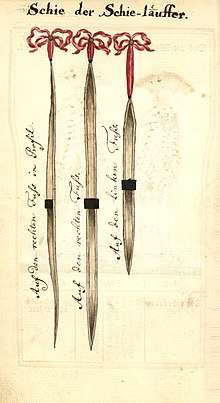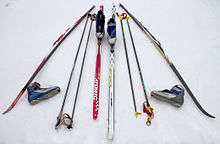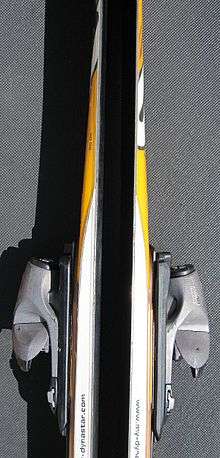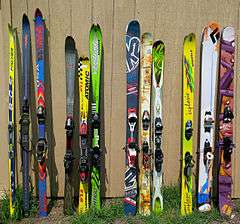Ski
A ski is a narrow strip of semi-rigid material worn underfoot to glide over snow. Substantially longer than wide and characteristically employed in pairs, skis are attached to ski boots with ski bindings, with either a free, lockable, or partially secured heel. For climbing slopes, ski skins (originally made of seal fur, but now made of synthetic materials) can be attached at the base of the ski.

Originally intended as an aid to travel over snow, they are now mainly used recreationally in the sport of skiing.
Etymology and usage
The word ski comes from the Old Norse word skíð which means "cleft wood",[1] "stick of wood" or "ski".[2] In Old Norse common phrases describing skiing were fara á skíðum (to travel, move fast on skis), renna (to move swiftly) and skríða á skíðum (to stride on skis).[3] In modern Norwegian the word ski has largely retained the Old Norse meaning in words for split firewood, wood building materials (such as bargeboards) and roundpole fence.[4][5][6] In Norwegian this word is usually pronounced [ˈʂiː]. In Swedish, another language evolved from Old Norse, the word is skidor (plural, pronounced [ˈɧîːdʊr]).
English and French use the original Norwegian spelling ski, and modify the pronunciation. Prior to 1920, English usage of skee and snow-shoe was often seen.[7] In Italian, it is pronounced similarly to Norwegian, but the spelling is modified accordingly: sci [ˈʃi]. Portuguese and Spanish adapt the word to their linguistic rules: esqui and esquí. In German, spellings Ski and Schi are in use, both pronounced [ˈʃiː]. In Dutch, the word is ski and the pronunciation was originally [ˈʃiː] as in Norwegian, but since approximately the 1960s changed to [ˈskiː]. In Welsh the word is spelled sgi.[1] Many languages make a verb form out of the noun, such as to ski in English, skier in French, esquiar in Spanish and Portuguese, sciare in Italian, skiën in Dutch, or Schi laufen or Schi fahren (as above also Ski laufen or Ski fahren) in German. Norwegian and Swedish do not form a verb from the noun.[6]
Finnish has its own ancient words for skis and skiing: "ski" is suksi and "skiing" is hiihtää. The word suksi goes back to the Proto-Uralic period, with cognates such as Erzya soks, Mansi tåut and Nganasan tuta.[8] The Sami also have their own words for "skis" and "skiing": for example, the Lule Sami word for "ski" is sabek and skis are called sabega. The Sami use cuoigat for the verb "to ski" (the term may date back to 10,000 years before present).[9][10]
History
The oldest wooden skis found were in Russia (c. 6300–5000 BCE), Sweden (c. 5200 BCE) and Norway (c. 3200 BCE) respectively.[11]
Nordic ski technology was adapted during the early 20th century to enable skiers to turn at higher speeds. New ski and ski binding designs, coupled with the introduction of ski lifts to carry skiers up slopes, enabled the development of alpine skis. Meanwhile, advances in technology in the Nordic camp allowed for the development of special skis for skating and ski jumping.
Asymmetrical skis

This type of ski was used at least in northern Finland and Sweden until the 1930s.[9] On one leg, the skier wore a long straight non-arching ski for sliding, and on the other a shorter ski for kicking. The bottom of the short ski was either plain or covered with animal skin to aid this use, while the long ski supporting the weight of the skier was treated with animal fat in similar manner to modern ski waxing. Early record of this type of skis survives in works of Olaus Magnus.[13] He associates them to Sami people and gives Sami names of savek and golos for the plain and skinned short ski.
Finnish names for these are lyly and kalhu for long and short ski.[14]
Single long ski
The seal hunters at the Gulf of Bothnia had developed a special long ski to sneak into shooting distance to the seals' breathing holes, though the ski was useful in moving in the packed ice in general and was made specially long, 3–4 meters, to protect against cracks in the ice. This is called skredstång in Swedish.[15]
Modern skis

Around 1850, artisans in Telemark, Norway, invented the cambered ski. This ski arches up in the middle, under the binding, which distributes the skier's weight more evenly across the length of the ski. Earlier plank-style skis had to be thick enough not to bow downward and sink in the snow under the skier’s weight. This new design made it possible to build a thinner, lighter ski, that flexed more easily to absorb the shock of bumps, and that maneuvered and ran faster and more easily.[16] The design also included a sidecut that narrowed the ski underfoot while the tip and tail remained wider. This enabled the ski to flex and turn more easily.[16]
Skis traditionally were hand-carved out of a single piece of hardwood such as Hickory, Birch or Ash. These woods were used because of their density and ability to handle speed and shock-resistance factors associated with ski racing. Because of Europe’s dwindling forests, the ability to find quality plank hardwood became difficult, which led to the invention of the laminated ski.[17] Beginning in 1891, skimakers in Norway began laminating two or more layers of wood together to make lighter cross country running skis. These evolved into the multi-laminated high-performance skis of the mid-1930s.[18]
A laminated ski is a ski composed of two different types of wood which are glued together. A top layer of soft wood is glued to a thin layer under a surface of hardwood. This combination actually created skis which were much lighter and more maneuverable than the heavy, hardwood skis that preceded them. Although lighter and stronger, laminated skis did not wear well. The water-soluble glues used at the time failed; warping and splitting along the glue edges (delaminating) occurred frequently and rapidly. In 1922, a Norwegian skier, Thorbjorn Nordby,[17] developed strong, waterproof glue which stopped the problem of splitting, therefore developing a much tougher laminated ski. Research and design of laminated skis rapidly progressed. In 1933, a new design technology was introduced involving an outer hardwood shell completely encasing an inner layer of lighter wood, successfully eliminating spontaneously splitting glue lines. This early design eventually evolved into an advanced laminating technique which is referred to today as single-shell casing technology.
In 1950, Howard Head introduced the Head Standard, constructed by sandwiching aluminum alloy around a plywood core. The design included steel edges (invented in 1928 in Austria,[16]) and the exterior surfaces were made of phenol formaldehyde resin which could hold wax. This hugely successful ski was unique at the time, having been designed for the recreational market rather than for racing.[19] 1962: a fibreglass ski, Kneissl's White Star, was used by Karl Schranz to win two gold medals at the FIS Alpine World Ski Championships.[19] By the late '60s fibreglass had mostly replaced aluminum.
In 1974, Magne Myrmo became the last world champion (Falun, 15 km cross-country) using wooden skis.[20][21]
In 1975, the torsion box ski construction design is patented.[22] The patent is referenced by Kästle, Salomon, Rottefella, and Madshus. In 1993 Elan introduced the Elan SCX model, skis with a much wider tip and tail than waist. When tipped onto their edges, they bend into a curved shape and carve a turn. Cross-country techniques use different styles of turns; edging is not as important, and skis have little sidecut. For many years, alpine skis were shaped similarly to cross-country, simply shorter and wider, but the Elan SCX introduced a radial sidecut design that dramatically improved performance. Other companies quickly followed suit, one Austrian ski designer admitting, "It turns out that everything we thought we knew for forty years was wrong."[16] Line Skis, the first free-ski focused ski company[23] inspired the newschool freeskiing movement with its twin-tip ski boards in 1995.[24] The first company to successfully market and mass-produce a twin-tip ski to ski switch (skiing backwards) was the Salomon Group, with its 1080 ski in 1998.[23][25]
Geometry
Described in the direction of travel, the front of the ski, typically pointed or rounded, is the tip, the middle is the waist and the rear is the tail. Skis have four aspects that define their basic performance: length, width, sidecut and camber. Skis also differ in more minor ways to address certain niche roles. For instance, mogul skis are softer to absorb shocks, powder skis are wider to provide more float and rocker skis bent upwards (reverse camber) at the tip and tail to make it easier to turn in deep and heavy snow.
Construction
Skis have evolved from being constructed from solid wood to using a variety of materials including carbon-Kevlar to make skis stronger, torsionally stiffer, lighter, and more durable. Ski manufacturing techniques allow skis to be made in one or a combination of three designs:
Laminate or sandwich

Laminated skis are built in layers. Materials such as fiberglass, steel, aluminum alloy, or plastic are layered and compressed above and below the core.[26] Laminated construction is the most widely used manufacturing process in the ski industry today. The first successful laminate ski, and arguably the first modern ski was the Head Standard, introduced in 1950, which sandwiched aluminum alloy around a plywood core.
Torsion box
The Dynamic VR7 introduced a new construction method in which a smaller wooden core was wrapped in wet fibreglass, as opposed to pre-dried sheets of fibreglass being glued to the core (essentially replacing metal sheets). The result was a torsion box, which made the ski much stronger. The VR7, and its more famous follow-on VR17, was the first fibreglass ski that could be used for men's racing, and quickly took over that market. Over time, materials for both the core and torsion box have changed, with wood, various plastic foams, fibreglass, kevlar and carbon fiber all being used in different designs. Torsion box designs continue to dominate cross-country ski designs, but is less common for alpine and ski touring.
Monocoque or cap
During the 1980s, Bucky Kashiwa developed a new construction technique using a rolled stainless steel sheet forming three sides of a torsion box over a wooden core, with the base of the ski forming the bottom. Introduced in 1989, the Volant skis proved expensive to produce, and in spite of numerous positive reviews, the company never became profitable. In 1990, the Salomon S9000 took the same basic concept but replaced the steel with plastics, producing a design they called "monocoque". Now referred to as the "cap ski" design, the concept eliminates the need to wrap the core and replaces this with a single-step process that is much less expensive to produce. Cap ski construction dominates alpine ski construction today.
Historical
The classical wooden ski consists of a single long piece of suitable wood that is hand-carved to produce the required shape. Early designs were generally rectangular in cross-section, with the tip bent up through the application of steam. Over time the designs changed, and skis were thinned out to the sides, or featured prominent ridges down the center.
Notable manufacturers
- K2[27] is a major US-based ski manufacturing company. In 1961 they were one of the first companies to begin producing and distributing fiberglass skis. Today K2 is primarily renowned for its wide variety of torsion-box ski designs. They sponsor several professional skiers and ski teams.
- Rossignol[28] is a French company established in 1907. Rossignol introduced its first fiberglass ski in 1964. Today the company offers a wide range of ski designs and produces over 500,000 pairs of skis per year. Rossignol also manufactures boots, bindings, and poles.
- Elan[29] is a Slovenian company, located in Begunje, notable in ski manufacturing for inventing shaped skis, also called parabolic skis, which made carve turns possible at low speeds and with short turn radius.
Types

1. Non-sidecut: cross-country, telemark and mountaineering
2. Parabolic
3. Twin-tip
4. Powder
In the history of skiing many types of skis have been developed, designed for different needs, of which the following is a selection.
Alpine
Ski design has evolved enormously since the beginnings of the modern sport in mid-19th-century Norway. Modern skis typically have steel edges, camber, side cut, and possibly reverse camber. During the 1990s side cut became more pronounced to make it easier to carve turns. Alpine skis typically have fixed-heel bindings. Specialised types of alpine skis exist for certain uses, including twin-tip skis for freestyle skiing, alpine touring ski,[30] and monoski.
Nordic
In Nordic skiing the skier is not reliant on ski lifts to get up hills, and so skis and boots tend to be lighter, with a free heel to facilitate walking. Styles of Nordic skiing equipment include:
- Cross-country skis are light and narrow, with a slight sidecut. Three binding systems are popular: Rottefella's NNN, Salomon's SNS profil, and SNS pilot. Ski bases are waxed to reduce friction during forward motion, and kick wax can also be applied for grip. Some waxless models have patterns on the bottom to avoid the necessity of grip waxing for classic technique.
- Skating skis are shorter than classic skis and do not need grip wax. The skating technique is used in biathlons.
- Ski jumping skis are long and wide.
- Roller skis have wheels for use on dry pavement, in the absence of snow.
References
- Caprona, Yann de: Norsk etymologisk ordbok. Oslo: Kagge forlag, 2014. ISBN 9788248910541.
- Merriam-Webster's Dictionary
- Grønvik, Ottar (2000). O̧ndurdís og o̧ndurgoð: studier over den førkristne religion i Norden. Oslo: Det norske videnskaps-akademi. ISBN 8290888325.
- Aasen, Ivar (1950): Ordbog over det norske Folkesprog. Kristiania: Carl C. Werner.
- Karlsen, Edgar (1993). Lærebok i lafting. Oslo: Universitetsforlaget. ISBN 8200410064.
- Bleken, Brynjulv (1973). Riksmål og moderat bokmål: en sammenlignende oversikt. Oslo: Aschehoug. ISBN 8203053025.
- "Winter Sport with Skees on the Snow" (December 20, 1903) New-York Tribune pg 2
- "[ETY] Eesti etümoloogiasõnaraamat". www.eki.ee. Retrieved 2018-07-20.
- Allen, E. John B. (2011), Historical Dictionary of Skiing, Historical Dictionaries of Sports, Scarecrow Press, pp. 1–14, ISBN 0810879778
- Gotaas, Thor: Norge: skisportens vugge. Oslo: Font forlag, 2011. ISBN 9788281690912
- Bays, Ted (1980) Nine Thousand Years of Skis: Norwegian Wood to French Plastic US National Ski Hall of Fame Press OCLC 6648572
- Bertram, Carl (1763). Vorstellung der sämtlichen Königl. Dänischen Armee. Copenhagen: C.W. Ahlefeld. p. 124.
- Olaus Magnus, 1555:1,4
- Facta 2001 part 15, page 385, finnish
- "Västerbotten 1971 nr. 2" magazine in Swedish, includes copious pictures of the ski and the associated equipment.
- Masia, Seth. "Evolution of Ski Shape". Retrieved 15 November 2012.
- Skiing Heritage Journal. Seth Masia, Dec. 2003. Web. 8 February 2010.
- Masia, Seth. The Splitkein Patent.
- Fry, John (2006). The story of modern skiing. Hanover: University Press of New England. ISBN 978-1-58465-489-6.
- Saur, Lasse (1999): Norske ski - til glede og besvær. Research report, Høgskolen i Finnmark.
- Kirkebøen, Stein Erik (15 April 2003). "Magne Myrmo siste VM-vinner på treski" (in Norwegian). Aftenposten. Retrieved 9 November 2019.
- Bjertaes, Gunnar. "Patent number: 4005875 Ski construction of the torsion box type". US Patent Office. Retrieved 15 November 2012.
- "afpworldtour - the history of competitive freeskiing".
- Skiing the wrong way since '95 Archived 2013-10-07 at the Wayback Machine
- Salomon Freeski Video 3 - Twin Tips.
- How Products Are Made Advameg Inc., 2010. Web. 8 February 2010.
- K2 Sports Archived 2015-09-06 at the Wayback Machine. K2 Sports, 2010. Web. 8 February 2010.
- Rossignol Archived 2011-07-26 at the Wayback Machine. Rossignol, 2010. Web. 8 February 2010.
- Archived 2013-01-22 at Archive.today. Élan, 2012. Web. 8 February 2010.
- "Silvretta". Silvretta.de. Retrieved 2011-10-25.